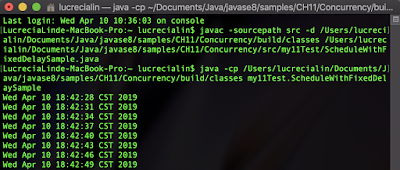Java - 從簡單例子看ScheduledExecutorService兩個方法差異:scheduleWithFixedDelay() vs. scheduleAtFixedRate()
先前情提要一下:JDK5開始提供ScheduledExecutorService讓我們能做工作排程。之前是由java.util.Timer和java.util.TimerTask做工作排程,不過限制會較多。
其中scheduleWithFixedDelay()和scheduleAtFixedRate()差別一開始難從文字理解,以下就直接從例子中分辨兩者吧:
scheduleWithFixedDelay() :當希望delay時間是1 sec時,則下個執行時間,會是上個執行時間+delay時間,在例子中會是2+1=3 sec為間隔執行一次。
e.g.
package my11Test;
/**
*
* @author lucrecialin
*/
import java.util.concurrent.*;
public class ScheduleWithFixedDelaySample {
public static void main(String[] args) {
ScheduledExecutorService myTimer
= Executors.newSingleThreadScheduledExecutor();
myTimer.scheduleWithFixedDelay(
() -> {
System.out.println(new java.util.Date());
try {
Thread.sleep(2000);
} catch (InterruptedException e) {
throw new RuntimeException(e);
}
}, 2, 1, TimeUnit.SECONDS);
}
}
下面為編譯結果:
scheduleAtFixedRate():當希望delay時間是1 sec時,有兩種執行結果:
case 1: 因執行時間為2 sec,大於delay時間的1 sec,因而「當執行時間大於指定週期」時,當上個執行完,就會馬上接著執行下一個,在例子中會是2 sec為間隔執行一次。
e.g.
package my11Test;
/**
*
* @author lucrecialin
*/
import java.util.concurrent.*;
public class ScheduleAtFixedRateSample {
public static void main(String[] args) {
ScheduledExecutorService myTimer
= Executors.newSingleThreadScheduledExecutor();
myTimer.scheduleAtFixedRate(
() -> {
System.out.println(new java.util.Date());
try {
Thread.sleep(2000);
} catch (InterruptedException e) {
throw new RuntimeException(e);
}
}, 2, 1, TimeUnit.SECONDS);
}
}
下面為編譯結果:
case 2: 因執行時間為0.5 sec,小於delay時間的1 sec,因而「當執行時間未超過指定週期」時,在例子中會是1 sec為間隔執行一次。
e.g.
package my11Test;
/**
*
* @author lucrecialin
*/
import java.util.concurrent.*;
public class ScheduleAtFixedRateSample {
public static void main(String[] args) {
ScheduledExecutorService myTimer
= Executors.newSingleThreadScheduledExecutor();
myTimer.scheduleAtFixedRate(
() -> {
System.out.println(new java.util.Date());
try {
Thread.sleep(500);
} catch (InterruptedException e) {
throw new RuntimeException(e);
}
}, 2, 1, TimeUnit.SECONDS);
}
}
下面為編譯結果:



留言
張貼留言